Adventure biking is all about getting out there on the open road, spending time in nature. There is something special about sitting next to a camp fire after a long day in the saddle, and then camping under the stars next to the bike that brought you there. Taking the right camping gear on an adventure bike trip is very important.
Camping with a bike is not the same as with a 4-wheel drive vehicle, however. Space is limited and it is important to keep the weight to a minimum. As a result you need to carefully plan which camping gear you pack.
Camping on an adventure bike trip requires compact, lightweight camping equipment. The most essential camping gear to take on an adventure bike trip includes:
- a weather proof tent;
- sleeping bag;
- camp cooking equipment;
- camping mattress;
- head torch; and
- clean drinking water
There are other items that may make your life more comfortable, but every piece of equipment adds to the weight of the bike. Let’s take a look at the essential items you can’t leave home without in a little more detail.
#1: Do I need a tent on a bike trip?
While you may not use the tent each night, it is a must in case it starts to rain. It will also keep out the wind which helps against the cold. In many parts of the world you can sleep outside under the stars. But if it is starts to rain, you are going to get wet if there is nowhere to hide.
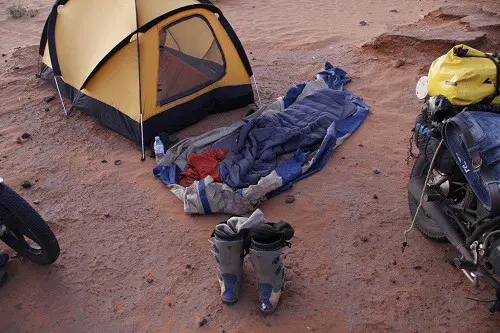
Your tent will most probably be the single heaviest thing you load onto your bike, so keep it light and small. If you are riding alone, the best place is behind you on the back seat against the rear luggage box.
Make sure your tent is rain resistant. Apart from shelter, a tent offers privacy for when you stay in a public campsite as well as a place to stow your personal belongings. While not secure, it helps to not display all your gear to prying eyes.
#2: Sleeping bag for an adventure bike trip
You can get away without a tent, but a sleeping bag is absolutely essential. A sleeping bag keeps you warmer than a blanket or duvet from similar material because you can zip yourself up inside.
Sleeping bags also fold away into a small ball, making it easy to pack on a motorcycle. Make sure about the temperature rating of the sleeping bag before you buy. This is primarily determined by the filling. Goose down will keep you warmer than the same weight of synthetic filling.
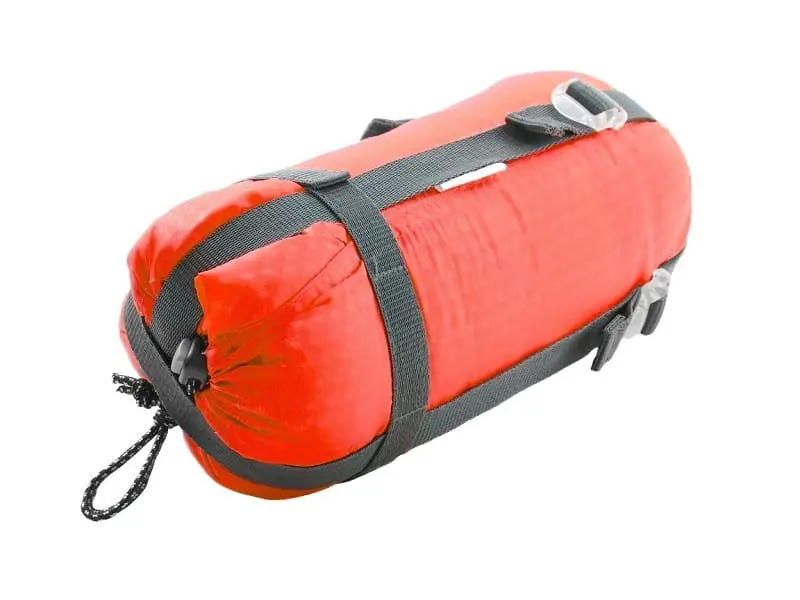
The temperate rating will depend on the climate you intend to travel in. Also keep in mind than men and women retain heat differently to one another. Women tend to need more insulation than men, so they may need different sleeping bags in the same weather. This is definitely true of me and my wife.
Down bags also fold away smaller, as it can compress more. The downside of down is that it can get moldy more easily if it gets wet.
#3: Camp stove and crockery that will fit in your bike luggage
There is nothing like making coffee before a day in the saddle, after a night under the stars. A small camp stove, aluminium kettle and a mug is all you need.
Camp stove
There are many different choices. The two most common options are (1) a burner with a separate fuel bottle, like the MSR range; and (2) a gas cooker that fits onto a butane gas canister.
I’ve used both. The MSR stove boils water quickly and it packs away easily. I like that the fuel is tightly sealed in a separate bottle. Just a word of caution, it does not like unleaded fuel despite the claim that it works. Mine puffed black smoke and deposited carbon everywhere. On the recommended white fuel (like benzine), however, it was perfect.
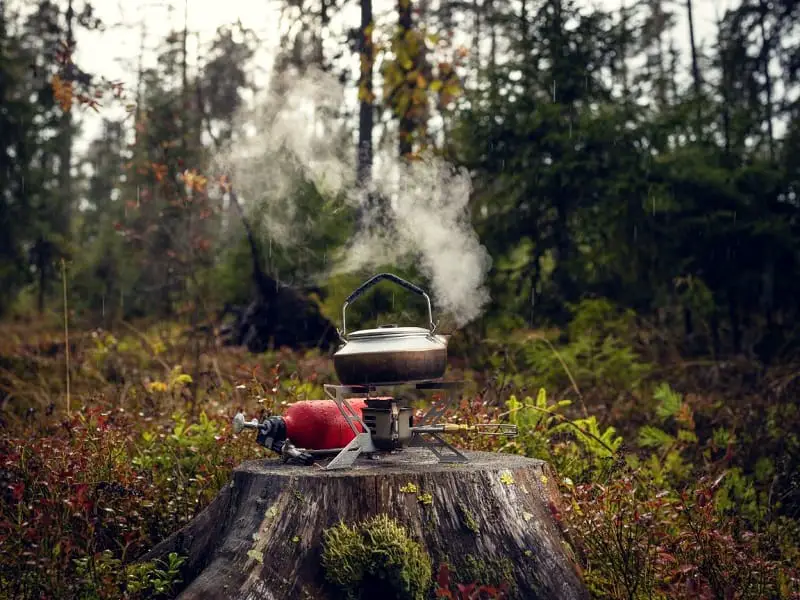
If you do get a butane stove, make sure you get the ones where you can remove the gas canister from the burner when stowing it away. There is less chance of it leaking than the models that puncture the gas can.
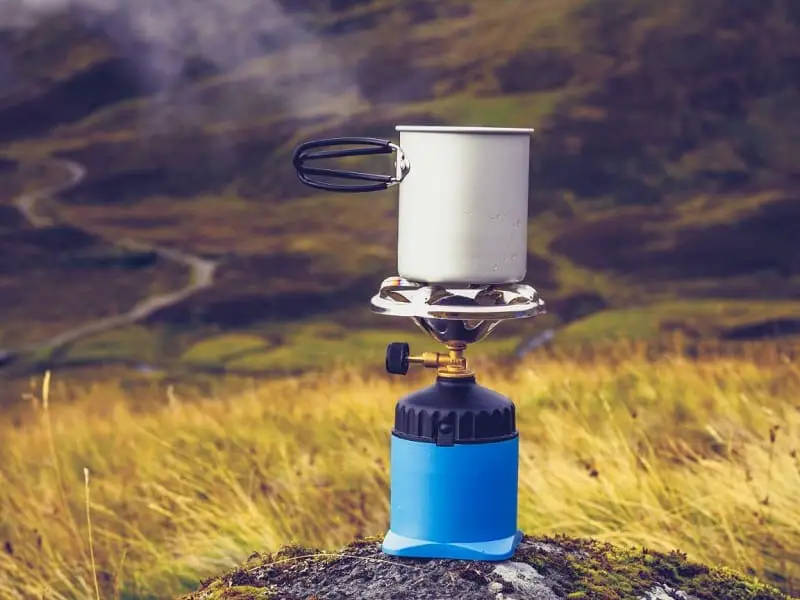
Crockery
You will need a small, lightweight kettle. Mine takes 900 ml and weighs next to nothing. It is enough for two large mugs of coffee. I usually also take a small aluminium pot for cooking instant noodles or whatever else we’re eating. I’ve also found this reasonably prices kettle on Amazon.

An aluminium mug can be used for coffee, wine or anything else you drink. You can also eat your serial and noodles from it. Collapsible bowls made from food-grade flexible silicon is also very handy and pack away easily.
A pocket knife and a spork (spoon-fork hybrid) is all you really need in terms of utensils. The best way to know what to take is to go on a short weekend adventure bike trip. Make a list of what you missed and only buy that. It is easy to go overboard with gadgets that you end up not using.
#4: Is a camping mattress really necessary on a bike trip?
A mattress is a contentious one. While not strictly necessary, it does help to sleep more comfortably after a long, hard day in the saddle. My wife refuses to sleep on the ground.
It does make a big difference whether you sleep on grass (comfortable), sand (okay) or rocks (not fun at all). The most efficient in terms of comfort versus size when rolled up is the self-inflatable mattresses like this one. They are more comfortable than a foam rubber mat and roll up into a smaller ball.
I managed to fit my mattress and sleeping bag in to my dry-bag, with all my clothes, on a 90-day African adventure bike trip. The only downside of these mattresses are that they can puncture easily if you are not careful, so make sure you don’t use it outside the tent without something underneath.
TIP: Leave the pillow. It is a waste of space. I slept like a baby on my bike jacket on our Cape to Cairo trip.
Francois Steyn – Crossing Africa
#5: Head lamp: an adventure biker’s best friend in the dark
Having light in camp is very handy. An LED head lamp is probably one of the most useful tools after dark. You can use it while working on your bike or cooking food. Having both hands free helps a lot. You can also use it inside the tent. There are many expensive head lamps out there, but my Petzl Tikka has served me well for many years. You can get it here on Amazon.
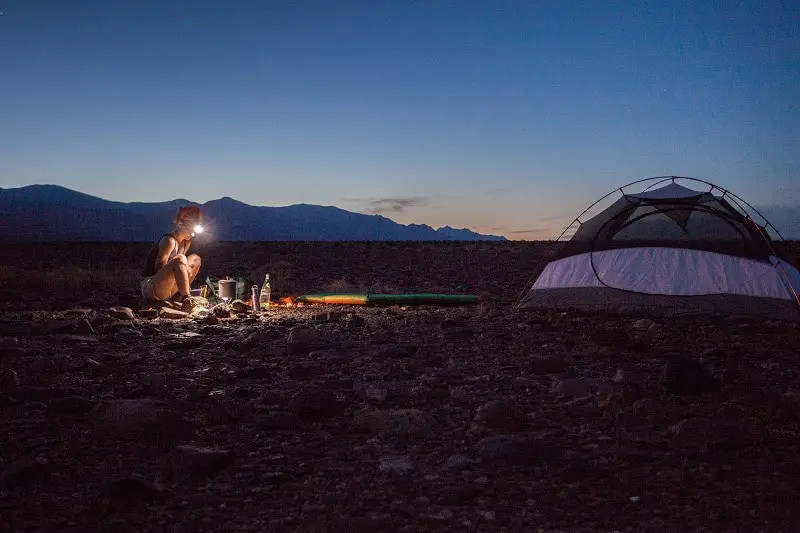
On long trips I usually take a small LED strip that plugs into the 12V socket on my bike, yet I can’t remember that I’ve ever used it before. The head lamp is just so much easier.
You can also use your smart phone as a torch if you need to.
#6: Don’t forget drinking water
I am mentioning drinking water here because it is so important.
It is also easy to forget about water if you travel in places where it is freely available. On most routes you can buy bottled water in each town and simply store it in your back-pack.
Whenever you leave town, always make sure you have more than enough. You never know when you get stranded somewhere for a few days due to a breakdown.

In some developing countries water from taps are not safe to drink. There are a few options to purify the water, for example chlorine tablets or drops. I carried both on our trip through Africa, and in 90 days I think I only used it once to add to water from a well.
Some of the ways I like to carry water on an adventure bike trip are:
- Hydration pack (like a Camelbak) for while I am riding;
- Army-style bottles strapped to the crash bars or luggage racks; and
- Bottled water stuffed into the cargo net
If you know you won’t see a town for a few days, make sure to take some disposable soda bottles with grey water for washing dishes and brushing teeth. You can flatten the bottles once empty and discard in the next town.
What else to keep in mind
Keep your gear dry
Make sure you pack your tent, sleeping bag and cooker where it won’t get wet in the rain. There is nothing worse than trying to sleep in a damp bed. You can either fit some of it into your hard luggage boxes, or throw a rain resistant cover over the top.
Fasten your gear properly
Fasten all your luggage properly. Not only will it be very inconvenient if you lose your camping gear, but it can be dangerous too.
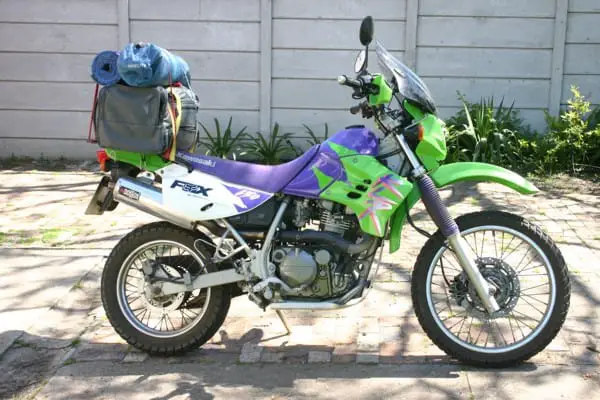
A tent falling off a bike is a dangerous obstacle for the rider behind you. And if a piece of equipment comes loose only halfway, there is a risk of it getting snagged in the chain or rear wheel. This could cause a serious accident.
Final thoughts
Camping comfortably is great, but don’t overdo it. Riding with an overladen bike is not only dangerous, but could result in shocks and brakes wearing prematurely or the frame braking on a bumpy road. If in doubt, leave it at home.
If you take the essentials mentioned above, you should be able to get some sleep. After a long day’s adventure riding, that should not be too much of a problem anyways.
Travel safe and enjoy!

